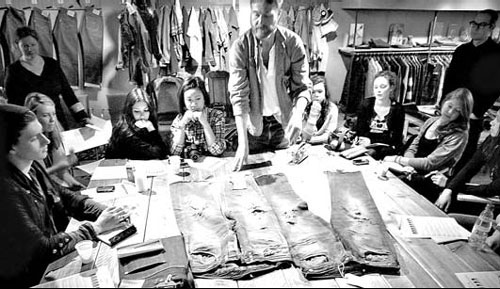School of jeans makers in a capital of denim
 |
|
Miles Johnson of Levi's Vintage Clothing lectured a pioneer master class at the Netherlands' House of Denim, which offers diplomas. James Veenhoff |
AMSTERDAM - Those who doubt that Amsterdam is a bright star in denim should have taken a wander in July through the "Blueprint" section of Modefabriek, the twice a year Amsterdam fashion fair. There, among the hip, young tattooed crowd, several dozen exhibitors showed just how much denim clothing the Netherlands designs and sells.
"In Holland everyone owns a good pair of jeans," said Lennaert Nijgh, an exhibitor. "But there's also a strong economic climate for brands to have their headquarters here."
Amsterdam is the center of the European jeans world. Pepe Jeans and Levi's Vintage have development offices in the Netherlands. G-Star, Scotch & Soda, Hilfiger Denim, Kuyichi, Blueblood, Kings of Indigo and a gaggle of smaller denim ateliers are headquartered here. Most Dutch denim ateliers put an emphasis on the actual fabric, which can be completely raw - untreated and left to wrinkle while worn - or elaborately treated.
Amsterdam will soon be offering diplomas in denim at the House of Denim Jean School. This month a group of students will start a three-year technical program in denim development at the Regional Community College of Amsterdam. They will graduate with the skills and connections to plug in to the European denim industry, said Mariette Hoitink, a well-known name in the Amsterdam fashion world and one of the school's founders.
The founders see the school at the crossroads of old-fashioned craftsmanship and new concepts of sustainability in design. When students graduate they will know the conventional trade - skills like cutting, sewing, stitching, washing - and will also bring new elements to the business, said James Veenhoff, a founder of the school and a former director of the Amsterdam International Fashion Week.
The class that starts this month will consist of 17 students, with an average age of 23, from varying backgrounds. Because of government financing, the tuition for the Dutch students is free. Ms. Hoitink and Mr. Veenhoff also envision creating a professional network, an archive and a denim lab, all under the name of House of Denim.
Mr. Veenhoff is counting on denim experts to provide guest lectures, short stints of in-house training and internships for his students. When denim luminaries like Adriano Goldschmied, a founder of Diesel, come to Amsterdam on business, he said, "I'll just ask them to pop by for a lecture beforehand."
Outside of the country the House of Denim network will be working to find new and cleaner sources and manufacturers. In October, a denim "embassy" will visit Delhi and Istanbul - sources of European denim.
A pioneering master class of 20 students went through a 10-week program in 2011. In the first week each student used the heavy denim sewing machines to create a denim work apron, a symbol of their status as apprentices.
Many aspects of the House of Denim are still on the drawing board, but the first regular students of the Jean School will be sewing their aprons this month.
















